Roasted cornish hens recipe with sticky rice stuffing
Juicy, golden roasted Cornish hens with a Taiwanese soy glaze — crisp skin, deep flavor, and easy make-ahead tips for the holidays. (1 hen per adult)
Servings: 4 servings
Equipment
- 1 14-inch wide or larger Dutch oven braiser/skillet (fits 3–4 hens with some space between)
- Twine (for trussing)
- Foil
Ingredients
Taiwanese Thick Soy Sauce (for marinating):
- 6 tbsp light soy sauce
- 6 tbsp dark soy sauce
- ½ cup water (120 ml )
- 4 tbsp mirin
- 6 tbsp coconut brown sugar
- 4 tsp Chinese black vinegar
- ¼ tsp garlic granules
- ¼ tsp coarse sea salt
- 2 small pinch five-spice powder
- 2 tbsp glutinous rice flour for slurry — see notes for alternatives
For the Cornish Hens:
- 3-4 Cornish hens 1–1.25 lb / 450–570 g each
- 1 large yellow onion about 11 oz / 310 g
- 2 large carrots about 13 oz / 370 g
- 3-4 tbsp ghee or softened butter about 1 tbsp per bird
- 2-3 tbsp orange, apricot, peach, or cranberry jam or marmalade
- ¼ cup chicken broth or stock 60 ml (add more if the pan has little juice)
Optional serving:
- Sticky rice stuffing serve on the side
Instructions
Before You Start:
- Plan ahead — this recipe includes an overnight marinade to give the hens their deep flavor. Make the sauce and let the hens marinate in the fridge overnight before roasting the next day.
- If you’re serving the hens with sticky rice stuffing, you can make it the same day, but I recommend preparing it ahead for a stress-free holiday. (See the recipe notes below for details.)
Make the sauce marinade:
- In a saucepan, combine light soy sauce, dark soy sauce, water, mirin, sugar, vinegar, garlic granules, salt, and five-spice powder. Bring to a gentle simmer over medium-low heat, stirring to dissolve the sugar (about 5–6 minutes). In a small bowl, mix glutinous rice flour with 4 tbsp water to make a smooth slurry, then whisk it into the sauce. Stir constantly until the sauce thickens slightly — it should be just thinner than maple syrup (about 2 minutes). Remove from heat and let cool; it will thicken a bit more as it cools.
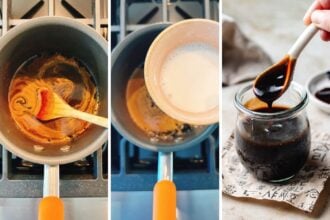
- If using tapioca starch, simmer for only 30 seconds. The sauce may look thick and gloopy at first — it will loosen overnight in the fridge. Please see more info in the recipe notes section below.
Marinate the hens:
- Pat the hens dry and trim the wing tips for better presentation. Transfer the hens to containers, breast side down, and coat them all over (including the cavity) with about 5 tbsp of thick soy sauce per bird. Marinate overnight in the fridge, then flip them breast side up in the morning.
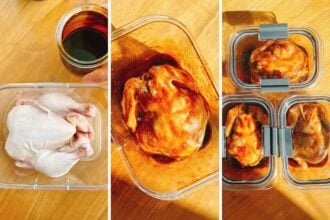
Prepare the vegetables:
- Cut the carrots into chunks and slice the onion into wedges. These will help prop up the birds during roasting. Set aside.

Prepare the hens for roasting:
- After marinating, let the excess marinade drip off before baking. Reserve the leftover marinade to use later as a brushing sauce. Truss the hens, then brush each bird with ghee or softened butter on the side facing up.
Roast:
- Preheat the oven to 400°F (200°C). Drizzle the roasting pan with olive oil, add the carrots and onions, and place the hens breast side up on top of the vegetables. Roast on the middle rack for 45–50 minutes total.
Baste with Fat and Glaze with Sweet Jam:
- After 30 minutes, remove the pan and baste the hens with the pan juices (mainly the rendered fat). For the sweet glaze, mix a spoonful of marmalade or jam with a splash of water and brush it over the breasts. Return the pan to the oven for another 15–20 minutes, basting every 10 minutes.
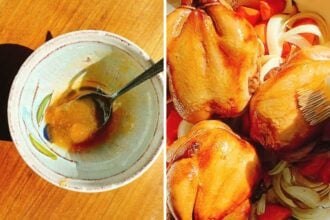
- Check frequently — if the skin browns too quickly, loosely cover those areas with foil. The internal temperature should reach 165°F (74°C) at the thickest part of the thigh (without touching the bone). Let rest for 15 minutes before serving.

Sticky rice stuffing:
- If serving with sticky rice, warm it in the microwave with a splash of water. Keep it covered and warm so the rice stays soft and chewy.

Make the pan jus:
- Transfer the hens and vegetables to a platter and cover with foil to keep warm. Add chicken stock to the roasting pan and scrape up the browned bits with a wooden spoon. Simmer briefly until the bits dissolve and the liquid reduces slightly. Pour into a serving bowl or gravy boat.
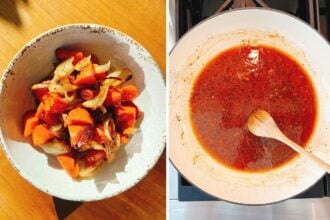
Serve:
- Transfer the roasted carrots and onions to a large serving platter and place the hens on top. Spoon the sticky rice stuffing around the birds so guests can easily serve themselves. Garnish with sliced scallions and serve hot with the pan jus on the side.
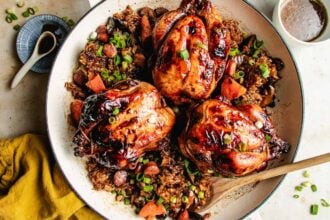
Notes
- Safe temperature: Cornish hens are done at 165°F (74°C). Insert the thermometer into the thickest part of the thigh without touching the bone or going into the cavity. Another way to check doneness is by slicing between the thigh and breast — if the juices run clear, the meat is cooked through.
- Glutinous rice flour (and substitutes):
- Glutinous rice flour gives the sauce a glossy, slightly sticky texture that thickens without turning gloopy. It also helps the sauce maintain its consistency after refrigeration without becoming watery.
- In a pinch, you can use tapioca or potato starch. They behave a bit differently from glutinous rice flour but still help thicken the sauce. Cook for no more than 30 seconds — otherwise, the sauce will become overly thick and gluey. The texture will be a little denser and less elastic, but it won’t affect the flavor when used as a quick substitute.
- Why I serve stuffing on the side: After extensive testing, I found that stuffing small birds like Cornish hens causes uneven cooking. By the time the stuffing reaches a safe internal temperature, the meat is overcooked. For food safety (as the FDA advises) and better texture, I recommend serving sticky rice stuffing on the side.
- Make-ahead:
- Chicken: Marinate up to 2 days in advance, rotating occasionally so all sides stay coated.
- Thick soy sauce: Prepare 4–5 days ahead and store in the fridge.
- Sticky rice stuffing: Make up to 3 days in advance. Reheat in the microwave on medium power, loosely covered, until warmed through. Keep it warm to maintain its soft, sticky texture — once cooled, it becomes dry and firm.
- How to truss a whole chicken - Jacques Pépin Techniques: How To Truss a Chicken for Roasting
Nutrition
Serving: 1hen | Calories: 963kcal | Carbohydrates: 43g | Protein: 64g | Fat: 59g | Saturated Fat: 20g | Polyunsaturated Fat: 10g | Monounsaturated Fat: 24g | Cholesterol: 370mg | Sodium: 2927mg | Potassium: 1141mg | Fiber: 2g | Sugar: 24g | Vitamin A: 6401IU | Vitamin C: 8mg | Calcium: 78mg | Iron: 4mg
